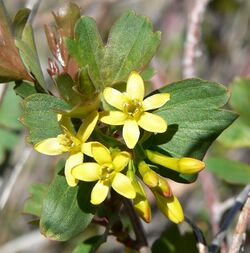Biology:Ribes aureum
| Golden currant | |
|---|---|

| |
| R. aureum var. aureum, Spring Mountains, Nevada. | |
| Scientific classification | |
| Kingdom: | Plantae |
| Clade: | Tracheophytes |
| Clade: | Angiosperms |
| Clade: | Eudicots |
| Order: | Saxifragales |
| Family: | Grossulariaceae |
| Genus: | Ribes |
| Subgenus: | Ribes subg. Ribes |
| Section: | Ribes sect. Symphocalyx |
| Species: | R. aureum
|
| Binomial name | |
| Ribes aureum Pursh 1813
| |
| Synonyms[1] | |
|
List
| |
Ribes aureum, known by the common names golden currant,[2] clove currant, pruterberry and buffalo currant, is a species of flowering plant in the genus Ribes native to North America.[3]
Description
The plant is a small to medium-sized deciduous shrub, 2–3 metres (6 1⁄2–10 feet) tall. The leaves are green, semi-leathery,[4] with 3 or 5 lobes, and turn red in autumn.[5]
The plant blooms in spring with racemes of conspicuous golden yellow flowers, often with a pronounced, spicy fragrance similar to that of cloves or vanilla. Flowers may also be shades of cream to reddish, and are borne in clusters of up to 15.[6] The shrub produces berries about 1 centimetre (3⁄8 inch) in diameter from an early age. The ripe fruits are amber yellow to black.[6] Those of variety villosum are black.[7]
Taxonomy
The species belongs to the subgenus Ribes, which contains other currants such as the blackcurrant (R. nigrum) and redcurrant (R. rubrum), and is the sole member of the section Symphocalyx.[8]
Varieties
- Ribes aureum var. aureum: below 910 m (3,000 ft) in the western U.S.[9]
- Ribes aureum var. gracillimum: below 910 m (3,000 ft) in the California Coast Ranges[10]
- Ribes aureum var. villosum – clove currant (syn: Ribes odoratum); native west of Mississippi River, but naturalized further to the east[11]
Distribution and habitat
Ribes aureum is native to Canada and the central United States West of the Mississippi River, but has escaped cultivation and naturalized in the Eastern United States.[12][11]
It can be found around gravel banks and plains around flowing water.[4]
Ecology
Pollinators of the plant include hummingbirds, butterflies and bees. The fruit is eaten by various birds and mammals.[13]
This currant species is susceptible to white pine blister rust (Cronartium ribicola), a fungus which attacks and kills pines, so it is sometimes eradicated from forested areas where the fungus is active to prevent its spread.[6][14]
Cultivation
R. aureum is widely cultivated as an ornamental plant, in traditional, native plant, drought tolerant, and wildlife gardens, and natural landscaping projects.[15] Unlike some other species of currants, Ribes aureum is in the remarkably drought-tolerant group of Ribes. Named cultivars have been introduced also.
Although the flowers are hermaphroditic, the yield is greatly benefited by cross-pollination.
Uses
The fruits are edible raw, but are very tart or bitter.[16] They are usually cooked with sugar and can be made into jelly.[4] The flowers are also edible.[6][5]
The berries were used for food, and other plant parts for medicine, by various Native American groups across its range in North America.[6][17]
References
- ↑ "Ribes aureum". World Checklist of Selected Plant Families (WCSP). Royal Botanic Gardens (Kew). http://www.theplantlist.org/tpl1.1/record/kew-2426191.
- ↑ "Ribes aureum". Natural Resources Conservation Service PLANTS Database. USDA. https://plants.usda.gov/core/profile?symbol=RIAU. Retrieved 22 October 2015.
- ↑ "Ribes aureum". http://www.pfaf.org/user/Plant.aspx?LatinName=Ribes+aureum.
- ↑ 4.0 4.1 4.2 Taylor, Ronald J. (1994) (in en). Sagebrush Country: A Wildflower Sanctuary (rev. ed.). Missoula, MT: Mountain Press Pub. Co. pp. 42. ISBN 0-87842-280-3. OCLC 25708726. https://www.worldcat.org/oclc/25708726.
- ↑ 5.0 5.1 Morin, Nancy R. (2009), "Ribes aureum", in Flora of North America Editorial Committee, Flora of North America North of Mexico (FNA), 8, New York and Oxford, http://www.efloras.org/florataxon.aspx?flora_id=1&taxon_id=250063214
- ↑ 6.0 6.1 6.2 6.3 6.4 USDA Species Profile
- ↑ "Ribes aureum var. villosum (Clove currant) | Native Plants of North America". The University of Texas at Austin. 2018-01-25. https://www.wildflower.org/plants/result.php?id_plant=RIAUV.
- ↑ {{citation | mode = cs1 | title = Ribes aureum | work = Germplasm Resources Information Network (GRIN) | url = | publisher = [[Organization:Agricultural Research ServAgricultural Research Service (ARS), United States Department of Agriculture (USDA) | access-date = }}
- ↑ Jepson Manual treatment for Ribes aureum var. aureum
- ↑ Jepson Manual treatment for Ribes aureum var. gracillimum
- ↑ 11.0 11.1 Morin, Nancy R. (2009), "Ribes aureum var. villosum", in Flora of North America Editorial Committee, Flora of North America North of Mexico (FNA), 8, New York and Oxford, http://www.efloras.org/florataxon.aspx?flora_id=1&taxon_id=250065805
- ↑ "Ribes odoratum". http://www.pfaf.org/user/Plant.aspx?LatinName=Ribes+odoratum.
- ↑ "Ribes aureum (Golden currant) | Native Plants of North America". The University of Texas at Austin. 2021-02-27. https://www.wildflower.org/plants/result.php?id_plant=RIAU.
- ↑ Marshall, K. Anna (1995), Ribes aureum, US Department of Agriculture (USDA), Forest Service (USFS), Rocky Mountain Research Station, Fire Sciences Laboratory, https://www.fs.fed.us/database/feis/plants/shrub/ribaur/all.html
- ↑ Las Pilitas Nursery horticultural treatment: Ribes aureum . accessed 1.30.2013
- ↑ Fagan, Damian (2019). Wildflowers of Oregon: A Field Guide to Over 400 Wildflowers, Trees, and Shrubs of the Coast, Cascades, and High Desert. Guilford, CT: FalconGuides. pp. 127. ISBN 978-1-4930-3633-2. OCLC 1073035766. https://www.worldcat.org/oclc/1073035766.
- ↑ University of Michigan (Dearborn): Ethnobotany
External links
- Jepson Manual Treatment – Ribes aureum
- United States Department of Agriculture Plants Profile: Ribes aureum (golden currant)
- University of Washington, Burke Museum
- Line drawing for Flora of Pakistan
- "Ribes aureum". http://www.pfaf.org/user/Plant.aspx?LatinName=Ribes+aureum.
Wikidata ☰ Q149376 entry
 |





